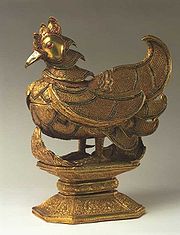
Betel container
Encyclopedia

Betel
The Betel is the leaf of a vine belonging to the Piperaceae family, which includes pepper and Kava. It is valued both as a mild stimulant and for its medicinal properties...
leaf. The container is in the form of a mythical bird known as a karaweik. This has been an important motif in Burmese art since the seventh century, and was believed to possess the ideal qualities of purity and gentleness. It is chicken like in its appearance with its feet, curled wings, pointed beak, wealth of overlapping body feathers, curled wings and upturned tail. The waisted stand is decorated with panels of floral ornament and at each end a leaf-shaped extension with foliage motifs, curved upwards to support the body of the stand.
Although containers in this form are common enough in Myanmar, this particular object is of great historical significance since it formed part of the Burmese regalia
Regalia
Regalia is Latin plurale tantum for the privileges and the insignia characteristic of a Sovereign.The word stems from the Latin substantivation of the adjective regalis, 'regal', itself from Rex, 'king'...
used by the last king, Thibaw Min
Thibaw Min
Thibaw Min was the last king of the Konbaung dynasty of Burma . His reign ended when Burma was defeated by the forces of the British Empire in the Third Anglo-Burmese War, on 29 November 1885, prior to its official annexation on 1 January 1886....
. The regalia was requisitioned by the British as indemnity at the end of the Third Burmese War in 1885 and remained under the custodianship of the Victoria and Albert Museum
Victoria and Albert Museum
The Victoria and Albert Museum , set in the Brompton district of The Royal Borough of Kensington and Chelsea, London, England, is the world's largest museum of decorative arts and design, housing a permanent collection of over 4.5 million objects...
from 1886 until 1964, when they were returned to Myanmar. This container was given to the Museum by the Government and people of Myanmar in recognition of its care of the regalia.

